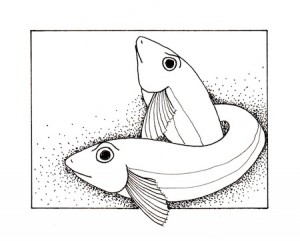By Mia Davidson and Jan Sattler
 Midnight grunion runs are part of California lore. Having a geographic range from the coastal waters of northern Baja California to most recently San Francisco, the California grunion (Leuresthes tenuis) are found most commonly off the coast of Los Angeles, Orange and San Diego counties. The name is derived from the Spanish word “gruñón” meaning grumpy. The schooling fish live year round near the shore and are five to seven inches long and slender in appearance. Having greenish tops, a bluish lateral line and silvery sides and bellies, their average lifespan is around four years. Although their feeding habits are not well known, California grunion are thought to be omnivores with a diet consisting of plankton, and other small creatures.
Midnight grunion runs are part of California lore. Having a geographic range from the coastal waters of northern Baja California to most recently San Francisco, the California grunion (Leuresthes tenuis) are found most commonly off the coast of Los Angeles, Orange and San Diego counties. The name is derived from the Spanish word “gruñón” meaning grumpy. The schooling fish live year round near the shore and are five to seven inches long and slender in appearance. Having greenish tops, a bluish lateral line and silvery sides and bellies, their average lifespan is around four years. Although their feeding habits are not well known, California grunion are thought to be omnivores with a diet consisting of plankton, and other small creatures.
California grunion reproductive behavior is unique. They are the only fish to completely leave the ocean en mass to lay their eggs on the sandy beach just after the new moon and full moon. In 1940, scientists discovered that this synchronicity correlated to the immediate nights following the highest monthly tides. Although able to predict when the grunion will spawn, scientists cannot determine where they will spawn. Gathering just off shore, normally a couple of male scouts ride a wave onto the beach and if all is clear, a dozen or sometimes thousands more follow to just above the high tide line. Once on land, the female wiggles her body into the sand tail first to deposit up to 3,000 eggs as the smaller males wrap themselves around her body fertilizing the eggs. Then the grunion ride a wave out to sea. For the next two weeks, the orange eggs incubate a few inches down in the warm, moist sand, undisturbed by waves until the next spring tide, which agitates the eggs allowing them to hatch and return to the ocean.
Predators include seabirds and shorebirds, sea lions, squid, dolphins and marine fish such as halibut, guitar fish and corbina; all have been observed inshore, even in the exposed splash zone, trying to feed on grunion. Pollution and human disturbances negatively impact the fish. Many cities have enacted limited grooming of beaches during certain months to protect the eggs of the grunion. Reproduction occurs February to September, peaking during April, May and early June. This phenomenon has been observed on various beaches in Laguna in recent years but observation opportunities require being careful of grunions sensitivity to light and noise. The catching of all fish including grunion is prohibited in Laguna Beach.
Laguna Beach residents Jan Sattler and Mia Davidson are year-round ocean swimmers and board members of Laguna Ocean Foundation which is actively involved in coastal resource management through all of its activities and programs. For more information, go to www.lagunaoceanfoundation.org




